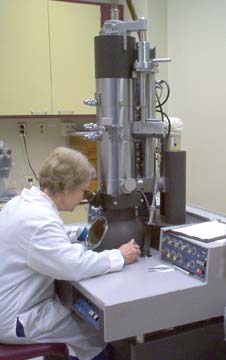Did You Know?: Animal Disease Diagnostic Lab
February 10, 2012
 |
|
A technician uses an electron microscope to look for viruses in a sample at the Indiana Animal Disease Diagnostic Laboratory. (Photo provided)
|
Today, ADDL serves as the primary animal diagnostic resource for private owners, public proprietors and veterinarians. Results from the lab's tests are used to diagnose diseases, establish treatment plans and provide surveillance for select diseases.
From July to December 2011, ADDL staff received, tested and analyzed more than 10,000 animal serum or tissue samples. Every sample requires specific shipping, labeling and handling procedures to preserve viability and maximize accuracy. This involves a careful accessioning system in which every sample receives an identification number and is distributed to the appropriate laboratory for testing.
"We perform almost 180,000 tests a year, so proper documentation and accessioning is vital," says Dr. Stephen Hooser, a veterinarian and director of ADDL. "Our staff understands that the work we do is important to owners, their animals, veterinarians and the economy of the state."
Due to the high amount of samples available, and special training at the U.S. Department of Agriculture Foreign Animal Disease Laboratory, ADDL diagnosticians are able to recognize a wide variety of animal diseases, including foreign animal diseases previously not seen in the U.S. In 2005, Dr. Duane Murphy, a veterinary pathologist in the ADDL, was first to recognize and report the most recent occurrence of rabbit hemorrhagic disease in the United States. In 2003, Dr. Ingeborg Langohr, a veterinary pathology resident in the ADDL, was among the first to recognize that prairie dogs sold in the Midwest were carriers of monkey pox, another foreign animal disease that causes illness in human owners.
When foreign or potentially harmful diseases such as these are identified, the lab works with the Indiana Board of Animal Health and the APHIS area veterinarian in charge to contain and eradicate the threat. APHIS, the Animal and Plant Health Inspection Service, is a unit of the U.S. Department of Agriculture.
This exposure to unusual or foreign animal diseases, and more often, to many diseases they will see when practicing, provides Purdue veterinary students with an unmatched curriculum component. During rotations at ADDL, veterinary students receive hands-on diagnostic experience supervised by faculty. This added dynamic of student learning is also valuable for the ADDL staff, Hooser says.
"Theses cases are like little mysteries to solve. We all enjoy sharing the forensic aspects of disease diagnosis with students and hearing their feedback," Hooser says. "Teaching doesn't only help the students. I think it makes me a much better diagnostician."

